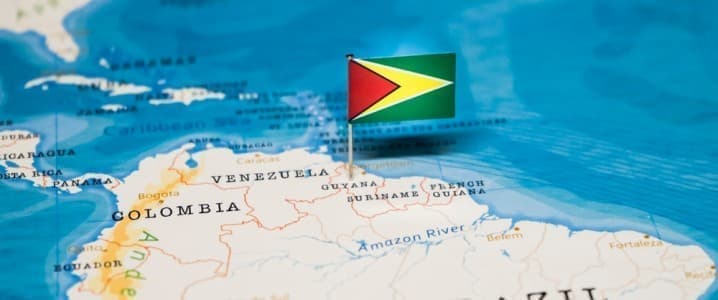
South America’s latest oil-producing nation, the former British colony of Guyana, is continuing to lay the groundwork for its oil boom.
In 2015, global energy supermajor ExxonMobil, which is the operator holding a 45% working interest, and partners Hess with 30% and CNOOC holding 25%, made their first discovery in offshore Guyana in the 6.6-million-acre Stabroek Block.
The Exxon-led consortium then went on to make a swath of high-quality oil discoveries with the latest occurring in April 2022. Exxon found oil with the Barreleye-1, Patwa-1, and Lukanani-1 wells which were drilled in the southeast of the Stabroek Block. That is five oil discoveries since the start of 2022 and a total of 31 finds since Exxon started drilling in the Block.
The latest discoveries saw Exxon upgrade its estimate for the Stabroek Block’s recoverable oil resources to nearly 11 billion barrels. That endows Guyana with more oil reserves than nearby Colombia, Ecuador, and Argentina, all of which rank among the top-5 petroleum-producing nations in South America.
In the short period since Exxon’s first 2015 discovery, Guyana has become the seventh-largest oil producer in Latin America and the Caribbean. The deeply impoverished former British colony has been pumping over 130,000 barrels per day since the Liza Unity floating, production, storage, and offloading vessel (FPSO) came online in February 2022 as part of the Liza Phase 2 development.
Exxon is developing the $9 billion Payara project in the Stabroek Block, which on commencing operations in 2024 will pump up to 220,000 barrels per day. The energy supermajor also recently committed to the $10 billion Yellowtail development, also in the offshore Stabroek Block, which will eventually produce 250,000 barrels daily after coming online in 2025. The projects being developed by the Exxon-led consortium in the Stabroek Block alone will catapult Guyana to become a leading top-20 oil-producing nation globally. Exxon estimates that it will be pumping 1.2 million barrels of crude oil daily from Stabroek by 2027, which based on 2021 oil production will see Guyana ranked 17th globally.
The latest developments underscore the growing importance of the Stabroek Block for Exxon with it expected to become a major source of crude oil production for the company. The block’s attractiveness is further enhanced by low operating costs. Liza Phase 1 has a breakeven price of $35 per barrel Brent while Liza Phase 2 once it reaches full production capacity is expected to break even at $25 per barrel.
The Payara and Yellowtail projects on commencing operations are expected to break even at $32 and $29 per barrel Brent respectively. Those industry-low breakeven prices underscore the considerable profitability of the Stabroek Block for the Exxon-led consortium, particularly when the low-carbon intensity of the oil being extracted is considered.
There is growing speculation that Guyana’s crude oil output will reach the 1.2 million barrels per day targeted by Exxon before 2027 because of the steady volume of new oil discoveries, rising exploitable oil resources, increased investment, and the building-out of vital industry infrastructure.
The national government in Georgetown is considering a range of measures aimed at accelerating Guyana’s oil boom by bolstering investment in exploration, oilfield development, and critical infrastructure. A key measure being considered by Georgetown is the formation of a state-run oil company, which if adopted will see Guyana follow the model used by neighboring oil producers in Latin America. Such a move would block the Exxon-led consortium from bidding on further exploration licenses and boost the government’s control over the industry, which until now has been in the hands of the global oil supermajor.
That would address some of the concerns raised regarding the deal made by Exxon with Georgetown, which analysts labeled as exploitive and unfavorable for the impoverished South American nation. Industry analysts believe that Georgetown is receiving a below-average return from Exxon, while think tank Global Witness believes that Guyana’s government has forfeited $55 billion through the deal. Guyana’s government is seeking a strategic partner to form such an enterprise with it flagging that such a partner could be found in the Middle East. While there is considerable industry experience in the Middle East, notably with nationalized oil industries and government-controlled petroleum companies, Georgetown could find a partner far closer to home.
Guyana’s government has held discussions with neighboring Brazil where national oil company Petrobras is driving one of the world’s largest offshore oil booms. There have been previous consultations with Brasilia regarding the construction of crucial oil industry infrastructure in Guyana, notably a deep-water port on Guyana’s Atlantic coast which will provide crucial support to the offshore oil industry. Such a facility would service not only Guyana but also northern Brazil where there is a shortage of critical transport infrastructure.
In recent discussions between Georgetown and Brasilia, four areas of development were identified; the deep-water port, a road-rail link, an energy corridor, and the introduction of fiber optics communications technology. As that infrastructure is developed and commissioned it will provide greater access to offshore Guyana for energy companies causing the former colony’s oil boom to accelerate. Such cooperation could make partnering with Petrobras a more logical choice than seeking a deal with a Middle Eastern entity, especially when the national oil company’s considerable deep-water drilling expertise are considered.
Source: https://oilprice.com/Energy/Crude-Oil/Guyana-Is-On-Track-To-Become-A-Leading-Global-Oil-Producer.html
